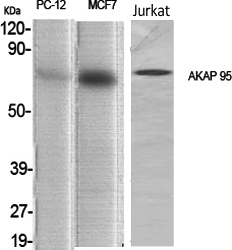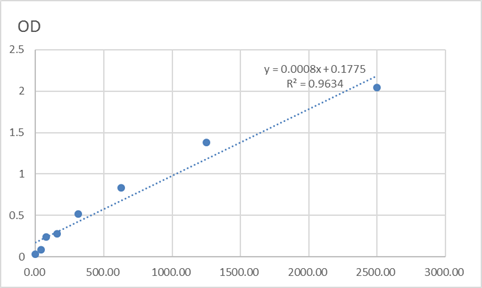Total AKAP 95 Cell-Based Colorimetric ELISA Kit
- Catalog No.:KA3467C
- Applications:ELISA
- Reactivity:Human;Mouse;Rat
- Gene Name:
- AKAP8
- Human Gene Id:
- 10270
- Human Swiss Prot No:
- O43823
- Mouse Swiss Prot No:
- Q9DBR0
- Rat Swiss Prot No:
- Q63014
- Storage Stability:
- 2-8°C/6 months
- Other Name:
- A-kinase anchor protein 8 (AKAP-8) (A-kinase anchor protein 95 kDa) (AKAP 95)
- Detection Method:
- Colorimetric
- Background:
- function:Anchoring protein that mediates the subcellular compartmentation of cAMP-dependent protein kinase (PKA type II).,similarity:Belongs to the AKAP95 family.,subcellular location:Associated with the nuclear matrix. Redistributed and detached from condensed chromatin during mitosis.,subunit:Binds to dimeric RII-alpha regulatory subunit of PKA during mitosis.,tissue specificity:Highly expressed in heart, liver, skeletal muscle, kidney and pancreas.,
- Function:
- mitotic sister chromatid segregation, M phase of mitotic cell cycle, mitotic cell cycle, M phase, nuclear division, sister chromatid segregation, DNA packaging, cell cycle, chromosome segregation, mitosis, mitotic chromosome condensation, cell cycle process, cell cycle phase, chromosome condensation, organelle fission, chromosome organization,
- Subcellular Location:
- Nucleus . Nucleus matrix . Nucleus, nucleolus . Cytoplasm . Associated with the nuclear matrix in interphase and redistributes mostly to chromatin at mitosis. However, mitotic chromatin localization has been questioned. Upon nuclear reassembly at the end of mitosis, is sequestered into the daughter nuclei where it re-acquires an interphase distribution. Exhibits partial localization to the nucleolus in interphase, where it colocalizes with UBTF/UBF, suggesting localization to the fibrillary center and/or to the dense fibrillary component. Colocalizes with GJA1 at the nuclear membrane specifically during cell cycle G1/S phase. .
- Expression:
- Highly expressed in heart, liver, skeletal muscle, kidney and pancreas. Expressed in mature dendritic cells.
- June 19-2018
- WESTERN IMMUNOBLOTTING PROTOCOL
- June 19-2018
- IMMUNOHISTOCHEMISTRY-PARAFFIN PROTOCOL
- June 19-2018
- IMMUNOFLUORESCENCE PROTOCOL
- September 08-2020
- FLOW-CYTOMEYRT-PROTOCOL
- May 20-2022
- Cell-Based ELISA│解您多样本WB检测之困扰
- July 13-2018
- CELL-BASED-ELISA-PROTOCOL-FOR-ACETYL-PROTEIN
- July 13-2018
- CELL-BASED-ELISA-PROTOCOL-FOR-PHOSPHO-PROTEIN
- July 13-2018
- Antibody-FAQs



